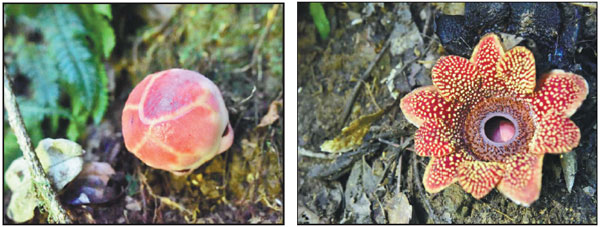Endangered flower rediscovered in China
Updated: 2016-01-28 08:07
By Cheng Yingqi in Xishuangbanna, Yunnan(China Daily)
|
||||||||
Rare parasitic plant last recorded in the deep south of Yunnan in the 1980s
A family of rare parasitic flowers that can match anything found in the movie Avatar recently reappeared in the rainforest of Xishuangbanna in Southwest China's Yunnan province.
Researchers from the Xishuangbanna Tropical Botanical Garden affiliated to the Chinese Academy of Sciences uncovered two photos on a local tourist guide's WeChat messaging app in early January that showed an odd mushroom-like flower - flaming red in color - with no leaves or roots of any kind.
|
From left: A bud and a blossom of rafflesiaceae found recently in the rainforest of Xishuangbanna in Yunnan province. Photos Provided to China Daily |
Recognizing that the flowers could be rafflesiaceae, which have not been seen in China for around three decades, the researchers carried out a field investigation and found two sites where the plants were blooming in the heart of the rainforest.
"Rafflesiaceae exist only in tropical rainforests in Southeast Asia. According to our records, researchers discovered the flowers in Xishuangbanna in the 1980s, but they have not been observed since," said Liu Guangyu, a researcher at the botanical garden.
Named after British statesman Sir Thomas Stamford Raffles, who collected a specimen from the island of Sumatra in 1818, rafflesiaceae have since been recorded across modern-day Indonesia, Thailand and Malaysia.
As parasites, rafflesiaceae do not need roots to absorb water or leaves for photosynthesis, and are wholly reliant on their hosts, vines in the genus Tetrastigma, for sustenance.
Some can grow extremely large, with a diameter of more than 1 meter, making them the largest flowers on Earth.
"Earlier research conducted by Western botanists inferred that rafflesiaceae develop such big blossoms because they do not need to waste any energy absorbing nutrients - all their needs are met by the host vine, so the flowers can use resources extravagantly," Liu said.
However, the flowers found in Xishuangbanna are much smaller than their record-breaking siblings, measuring about 10 to 12 centimeters in diameter.
"We are now using cell samples taken from the flowers to carry out DNA tests so we can find out whether this is a new species or just a relative of the rafflesiaceae found elsewhere," said Tan Yunhong, a researcher specializing in plant classification at the botanical garden.
Yet this analysis could be complicated by the fact that rafflesiaceae often share some of their genes with the host plant, in a process known as horizontal gene transfer.
"We will only use the most stable genes to analyze the specimens' genetic relationship with other parasitic plants, but we will not know how horizontal gene transfer will influence the result until we finish gene sequencing and start the analysis," Tan said.
Whatever the outcome, this latest study into rafflesiaceae is almost certain to uncover something new about the mysterious family of plants, as so little is known about them.
"We do not know how they appear, grow or are fertilized. Maybe after a while they will disappear again, so we have to carry out our research quickly while the flowers are still there," Liu said.
All known species of rafflesiaceae have been classified as endangered species by the International Union for Conservation of Nature, a global environmental NGO.
chengyingqi@chinadaily.com.cn
(China Daily 01/28/2016 page7)
- A glimpse of Spring Rush: little migrant birds on the way home
- Policy puts focus on genuine artistic students
- Police unravel market where babies are bought, sold as commodities
- More older pregnant women expected
- Netizen backlash 'ugly' Spring Festival Gala mascot
- China builds Mongolian language corpus
- Thousands of beckoning cat on display in Japan's Goutoku Temple
- Chinese fishing boat capsizes off S. Korean island: Yonhap
- 42 cases of Zika infection reported in N.E. Panama
- US announces further amendments to Cuba sanctions
- Special envoy to visit Laos and Vietnam
- El Nino expected to wreak havoc in S. America well into 2016

 Sea ice traps boats as cold wave sweeps across East China
Sea ice traps boats as cold wave sweeps across East China
 10 tourists grab free money in one minute in East China
10 tourists grab free money in one minute in East China
 Warm colors at sunrise cast off the chill in Qingdao
Warm colors at sunrise cast off the chill in Qingdao
 Artists use many techniques to create New Year monkeys
Artists use many techniques to create New Year monkeys
 Villagers make sweet potato vermicelli in China's Guangxi
Villagers make sweet potato vermicelli in China's Guangxi
 Creation of China Daily's Tibetan-style font
Creation of China Daily's Tibetan-style font
 Drone makers see soaring growth but dark clouds circle industry
Drone makers see soaring growth but dark clouds circle industry China's Zhang reaches Australian Open quarterfinals
China's Zhang reaches Australian Open quarterfinals
Most Viewed
Editor's Picks

|

|

|

|

|

|
Today's Top News
National Art Museum showing 400 puppets in new exhibition
Finest Chinese porcelains expected to fetch over $28 million
Monkey portraits by Chinese ink painting masters
Beijing's movie fans in for new experience
Obama to deliver final State of the Union speech
Shooting rampage at US social services agency leaves 14 dead
Chinese bargain hunters are changing the retail game
Chinese president arrives in Turkey for G20 summit
US Weekly

|

|








